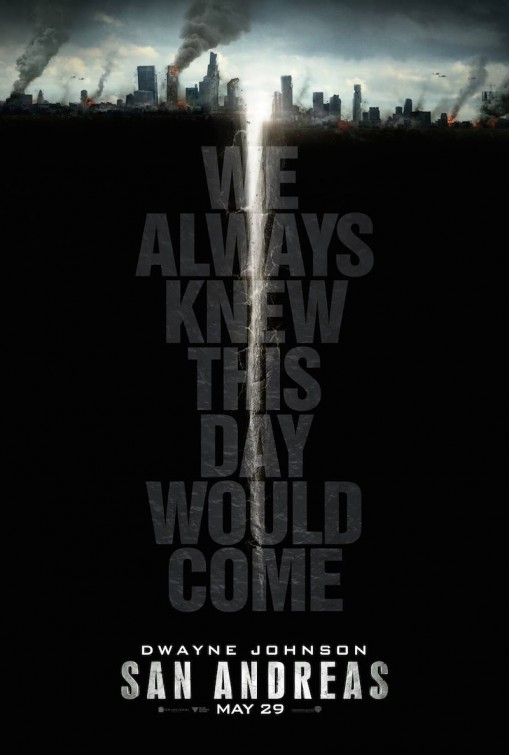Movie Breakdown: San Andreas (Noah)
People are doing traditional-style reviews all over the web, so we decided to try something different. In each “breakdown” we’ll take a look at what a film’s marketing led us to believe, how the movie actually played, and then what we learned from it all. Read on!
The Impression:
Disaster-style action flicks have taken a real nose-dive since the heyday of Roland Emmerich’s enviro-madness. That said, the way Warner Brothers has been pushing the film like the dramatic, explosion-porn crown jewel makes me wonder if there’s actually something there, lurking amongst the shattered buildings.
The Reality:
You could hang the massive faults of Brad Peyton’s San Andreas on the two-by-four straight line of Dwayne Johnson’s shoulders. The massive ex-wrestler, though now almost fully reimagined as a Hollywood type actor, doesn’t seem to be able to shed the glorified camp of the wrestling ring. His Ray Gaines, a former military man-turned rescue pilot has all the makings of an early 90s protagonist: the aforementioned physique, a family broken by tragedy, the skills and potential to do, well, just about anything, and a stunning lack of personality. The burrs and barbs – flaws, even – of the average personality, worn down in favor of a Captain America like superhero, driven by duty and grief (sort of) to save his family in the wake of a coast-shattering earthquake. Oh yeah, this film has an earthquake, several earthquakes in it, and much like The Rock’s steely visage and empty, benevolent soul, the quakes are there to look good and kick ass without actually mustering any sort of real emotion. The film is an homage to the mid-90s disaster spectacles like Dantes’s Peak and Volcano that defined blockbusters for a stretch of years, and this isn’t for the best. All the cheap ploys – swelling strings, Dwayne Johnson grimly staring out over a broken (landscape), a cheeky British kid, massive, unheralded destruction – are here in force. Twenty years ago, when the American public was still happy to slosh around in shitty story lines and bad acting for the sake of some nicely put together destruction, this crap would’ve worked, but now it almost feels like Peyton is constructing an art piece, one that pushes the concepts of films like 2012 and Independence Day to their most extreme point (every quake a city destroyer, every line a potential tearjerker) to highlight just how far we’ve come. A nicer reviewer might walk away thinking this absurd thought, but I am not that, and as the earthquakes rumbled and The Rock defied vehicular gravity and characters disappeared (not into the carnage, just out of the story) I did not find myself yearning for the days of Pierce Brosnan racing a volcano, or Bill Paxton chasing a tornado. You could write down the major plot points of any action film made in the last 20 years and set a timer, and you better believe Brad Peyton is going to tick them off one by one. Maybe, possibly, you’ll find some nostalgic solace in the sight of the West Coast’s most famous landmarks crumbling into nothing, or maybe you’ll enjoy the paper thin love story between Dwayne Johnson and Carla Gugino (squandered here as helpless, but sexy, ex-wife), but it won’t be your enjoyment of this film that resonates, it’ll be the memories of an era films that have thankfully, hopefully, passed on.
The Lesson:
I will say this, watching the city you live in crushed by earthquakes, tsunamis, and looters is strangely, deeply scary. The level of fear in the audience (of hard-nosed critics) was much higher than I would have expected, and I can only imagine most of this stems from a sort of cinematic PTSD for those who’ve lived through San Francisco’s worst shakers and those who’ve come to grips with the idea that someday they probably will.


